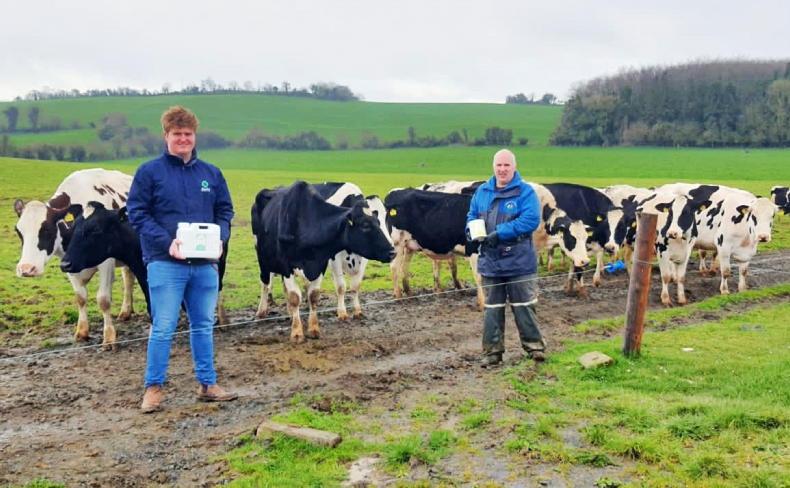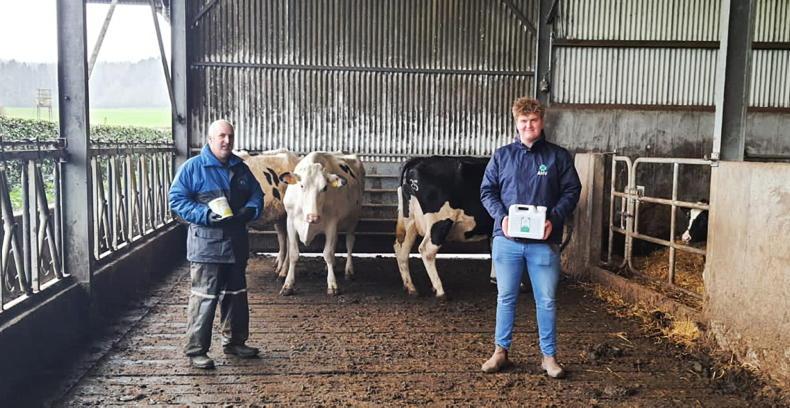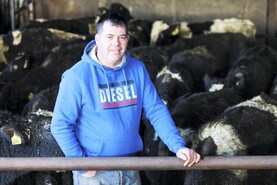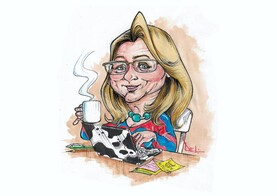“Two-thirds of the cows calve in the spring. The remainder calve in the autumn,” Brian commented.
“We actually calve 230 animals in the year, which allows us to sell 50 calved heifers in any 12-month period.
“Upping cow numbers is not part of our business plan moving forward. Our aim is to focus on the quality of the breeding stock within the herd that we already have.”
Brian confirmed that milk recording has been a vital tool for his herd management within the business.
He further explained: “Specifically, we have used milk recordings to identify cows with high cell count readings within the herd.
“This then led to the problem of what to do with cows that have tremendous production potential but are also prone to producing high cell count milk.
“I am very reluctant to continually use antibiotics in such cases and I had been on the lookout for other options, especially with the new regulations coming down the line in 2022. It was time to secure an effective way of managing the problem.”
A new approach to problem cows
Brian continued: “Just over a year ago, I became aware of the AHV solution range and decided to try their products as part of the overall health management programme for the herd.”
The first step in this process was to select 10 cows with cell count problems. The AHV team were very helpful during this procedure.
Each of the 10 cows in the group received an AHV Extra Tablet. It was then a case of waiting to see the results, which was made easier through the data received from milk recording.
According to Brian, three of the older cows in the group did not respond to the tablets at all. However, the other seven did register significant and sustained reductions in cell count over the following months.

“To be honest, I was expecting that the older animals would have reacted in this way. And, in fact, the AHV team had forewarned me to expect this result, as the cows were more than likely chronic with udder tissue damage.
“However, the response generated by the younger animals was very encouraging. All the more welcoming was the fact that their cell count levels subsequently remained low.”
AHV’s solution to acute mastitis
Brian went on to confirm that he has not used an antibiotic tube on any of the cows in the herd for the past year.
Moreover, within this time period, he has had to deal with three cases of E coli mastitis.
He commented: “Normally, E coli mastitis would hardly rear its head on the farm. Thankfully, in all three instances, it was a case of identifying the problem at a very early stage.
“Each affected cow received a Quick Tablet, an Extra Tablet, plus two bottles of the AHV anti-inflammatory ASPI.
“All three cows were saved. Two of the animals continued in full milk, with one being a bit light in one of her quarters.
“But it could have been all so different. E coli mastitis has the potential to kill a cow very quickly.”
Brian puts great store in the use of the ASPI anti-inflammatory.
He commented: “It delivers almost instant pain relief and helps reduce swelling. This is critically important in allowing a cow, and all other animals for that matter, to recover from any form of stress as quickly as possible.”
AHV sales consultant Mark Sugrue was quick to point out that at the first signs of issues, it is advisable to stomach drench the cow with 25 litres of an isotonic drench at least twice a day until she is eating again, to maintain energy and hydration to the cow.
It is so important to support the cow in this way when she is unable to eat and drink herself.
Brian continued: “In all instances when clots are identified in milk, the affected cow will receive an Extra Tablet and a bottle of ASPI.
“The immediate response, by using these AHV solutions, will be a significant increase in the number of clots coming from the cow over the following days.
“However, this is simply the animal cleaning out her udder completely from the top down. Invariably, everything will come back to normal once the cleansing process has finished.”
Brian concluded: “Using the AHV solution range has brought about a step change in the way that we manage cell count and udder health-related issues on the farm.
“However, I am more than happy to discuss the steps that we have taken with any other milk producer in the country and the results they have generated for us.”
AHV’s Mark Sugrue commented on the importance of ensuring optimum udder health by cleaning out the udder during the lactation and stated that there is a direct relationship between poor udder health and cull cows in the dairy industry.
“It is a priority for any dairy farmer to ensure that the high producing cows have good longevity in the herd, as it is these cows that reach three, four, five or six lactations and are the cows that are profitable and worth breeding from.
“By cleansing out the udder tissue in early and late lactation, you are giving the cow her best chance at being healthy, productive and being a valuable asset to the business.
“At AHV, we focus on the longevity of these good producing cows from the time they start to calve until they are dried off.
“By reducing metabolic and energy imbalances, promoting good fertility and ensuring healthy udders, we are confident we can make a large impact on the longevity and profitability of a herd.”
For further help and advice on your herd animal health, contact your local AHV consultant by clicking here.






 This is a subscriber-only article
This is a subscriber-only article





